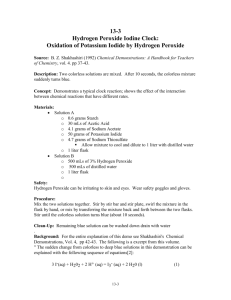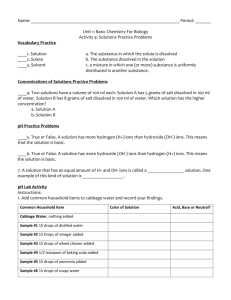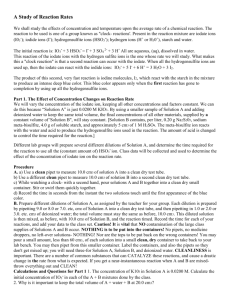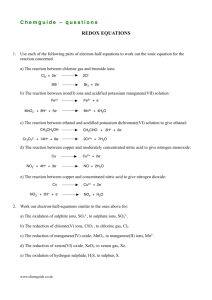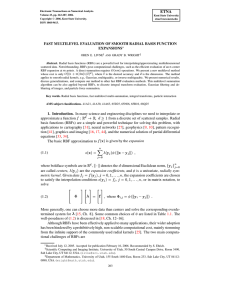lab - iodine clock
advertisement
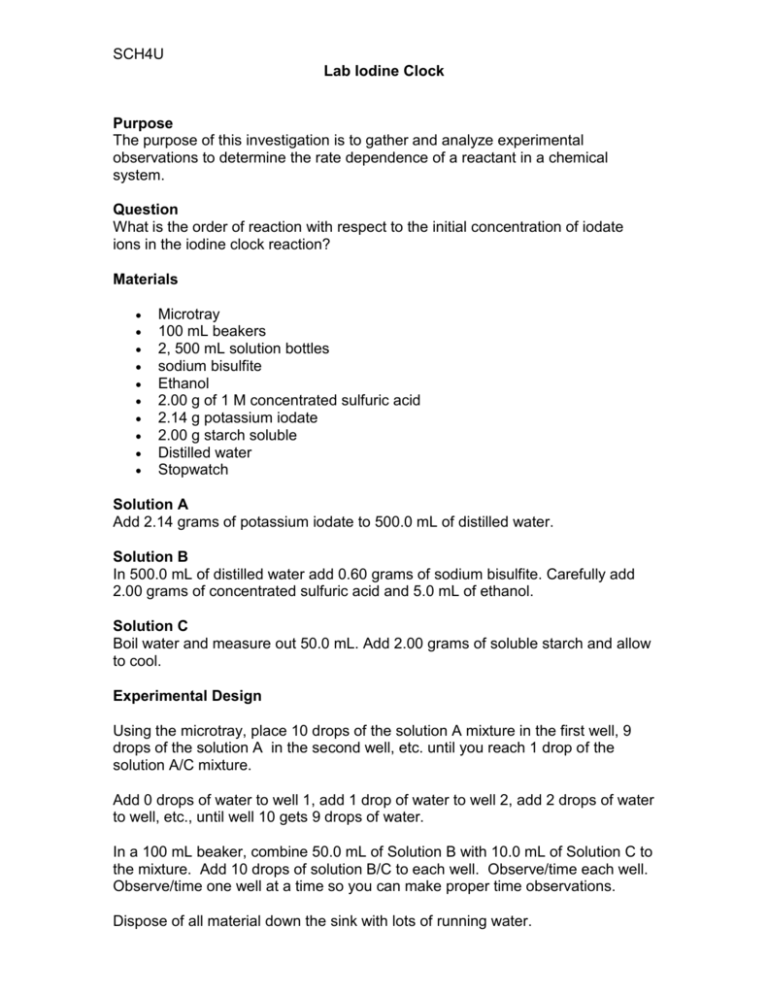
SCH4U Lab Iodine Clock Purpose The purpose of this investigation is to gather and analyze experimental observations to determine the rate dependence of a reactant in a chemical system. Question What is the order of reaction with respect to the initial concentration of iodate ions in the iodine clock reaction? Materials Microtray 100 mL beakers 2, 500 mL solution bottles sodium bisulfite Ethanol 2.00 g of 1 M concentrated sulfuric acid 2.14 g potassium iodate 2.00 g starch soluble Distilled water Stopwatch Solution A Add 2.14 grams of potassium iodate to 500.0 mL of distilled water. Solution B In 500.0 mL of distilled water add 0.60 grams of sodium bisulfite. Carefully add 2.00 grams of concentrated sulfuric acid and 5.0 mL of ethanol. Solution C Boil water and measure out 50.0 mL. Add 2.00 grams of soluble starch and allow to cool. Experimental Design Using the microtray, place 10 drops of the solution A mixture in the first well, 9 drops of the solution A in the second well, etc. until you reach 1 drop of the solution A/C mixture. Add 0 drops of water to well 1, add 1 drop of water to well 2, add 2 drops of water to well, etc., until well 10 gets 9 drops of water. In a 100 mL beaker, combine 50.0 mL of Solution B with 10.0 mL of Solution C to the mixture. Add 10 drops of solution B/C to each well. Observe/time each well. Observe/time one well at a time so you can make proper time observations. Dispose of all material down the sink with lots of running water. Observation Table 1: Effect of Concentration on Reaction Time Well Volume of solution A (drops) Volume of water (drops) [IO3-] (mol/L) Volume of solution B/C (drops) [IO3-] (mol/L) Elapsed time (s) 1 2 3 4 5 6 7 8 9 10 Analysis 1. Using the last two columns of your observation table, complete the table below. Table 2: Data of Iodine Clock Reaction to Establish Order of Reaction [IO3-] (mol/L) Elapsed time (s) ln [IO3-] 1/[IO3-] 2. Plot and label two graphs ON GRAPH PAPER to identify the order of the reaction with respect to concentration of iodate ions. ln [IO3-] versus t (linear for a 1st order reaction) 1 / [IO3-] versus t (linear for a 2nd order reaction) 3. Answer the question of the lab (based on your graphs). 4. Identify independent, dependent, and constant variables. 5. Why is it important to add specific volumes of water to the wells in the microtray? How does it work? This reaction is referred to as the Landolt Clock Reaction. There are three steps in the process that cause this amazing reaction. When you prepare the Solutions A, B, and C, the chemicals begin to mix and form new chemical compounds. This is a very slow reaction, so you don’t see any outward changes. When you begin to pour the solutions together a much faster reaction occurs, which leads to the third reaction which is instant. Suddenly, and immeasurably quickly, the clear liquids turn into a jet black iodine-starch complex. These reactions happen at different intervals because different chemicals react at different speeds. Additional Info Discussion of the Chemistry... The sudden change from a colorless solution to the blue-black solution is the result of four sequential reactions. First, the bisulfite ions (HSO3-) reduce some of the iodate ions (IO3-) to form iodide ions (I-). Next, the iodide ions (I-) are oxidized by the remaining iodate ions (IO3-) to form triiodide ions (I3-). The solution now consists of triiodide ions (I3-) and soluble starch. In the third reaction, the triiodide ions (I3-) get reduced by the bisulfite ions (HSO3-) to become iodide ions (I-). That continues until all of the bisulfite has been consumed. Finally, the triiodide ions and starch combine to form the dark blue-black starch complex that looks like ink. 1- 1- 1- 2- IO3 + 3 HSO3 I + 3 SO4 + 3 H 1+ 1- 1- 1+ 1- 6 H + IO3 + 8 I 3 I3 + 3 H2O 1- 1- 1- 2- H2O + I3 + HSO3 3 I + SO4 + 3 H 1- -1 1+ 2 I3 + Starch Starch—I5 complex (blue) + I -1

